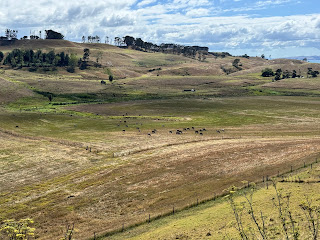61.7 miles, 1594’ climbing
Lodging: Arapuni Backpackers Lodge
Weather: Cool and overcast, turning to hot and muggy
After walking around to find an open breakfast place we settled for McDonald’s, then we pedaled out of Paeroa on a gravel rail trail, well used by cyclists. It was part singletrack and part double track, very pleasant in the morning coolness. Every 100 meters or so there were wooden traps set along the side with an egg used as bait. We saw the same yesterday. Finally we saw one with a brindle-coated critter in it, but we couldn’t tell what it was. A local said they trap possums, rats, ferrets… anything that endangers the local birds and plants. We saw a bunch of pukekos and what appeared to be hawks and a heron.
We rolled into the town of Te Aroha, larger than Paeroa, in time for a coffee and pastry along the main street. The town was full of motorcycles, and a local told us that there was a poker ride today. We headed out across a bridge where three local e-bikers chatted with us about riding trails. The next 25 or so miles to Matamata were on a paved bike trail that was separated from the busy road.
Matamata is home to Hobbiton, where the Lord of the Rings movie was filmed. There were signs for tours, a tower, and movie sets, but no mention of hobbits having hairy toes. The homes were large and landscaped, and the main street was full of shops and restaurants, a bigger place than we’ve been thru in a while. We stopped for lunch, ice cream, and the requisite hobbit home pictures with our bikes.
Leaving Matamata, we soon found ourselves on the shoulder of a very busy highway with big trucks blowing us around periodically, not the most fun riding of the day. We were happy to turn off onto the Waikato River Trails next to Lake Karapiro. The narrow trails swooped along the shoreline with ferns and dense trees in the humid afternoon. To our surprise, we spotted 8-10 black swans swimming in the lake, and a covey of quail scurried across the road. Finally we turned off for Arapuni, a small town beside the lake where we got a room at Arapuni Backpackers, which offers rooms, camping, showers in a beautiful garden behind a home. There were a number of other riders there as well. The owner has a lovely garden and offered us tomatoes.













































